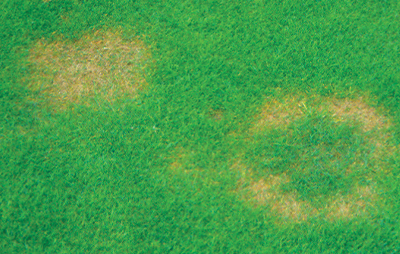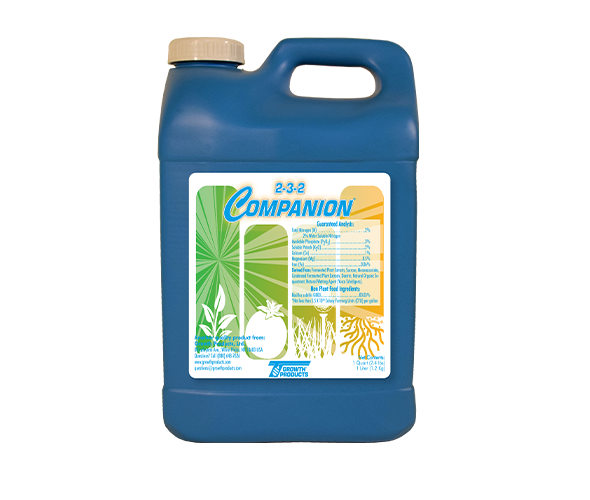The majority of turf diseases are caused by fungal pathogens but some fungi are more strongly pathogenic than others. Many of the common cool season turf diseases are caused by fungi that rely on a weakened plant and therefore reducing disease incidence and severity is often aligned to maintaining a strong sward. With on-going changes to European Legislation relating to pesticide use, it is more important than ever that an integrated approach to disease management is employed and central to this is an understanding that the cultural conditions can limit disease development. Making use of the genetic variation that exists between grass types and cultivars can also minimise disease development through a sward. By managing rootzone quality and using weather information services, it can also be possible to pre-empt disease outbreaks and plan an efficient integrated management strategy.
Pathogen: Gaeumannomyces graminis var. avenae
Susceptible Species: Traditionally found on Agrostis sp. but now also commonly found on Poa annua as well.
Take All Patch is a disease that will have initial infection during late spring, but visual symptoms will only start to show later in the summer and early autumn. It is a disease often seen in new sand-based constructions as it is poor at competing with rootzone antagonistic microbiology. For this reason it can also be found where rapid pH changes affect microbial populations and where intensive pure sand top dressing changes rootzone microbial balance.
Conditions which are known to increase the likelihood of disease development include thatch build-up, alkaline soil (but can occasionally be seen as low as pH 5.5), poor drainage and low manganese levels in the soil. Low soil manganese levels are often associated with this disease as the pathogen oxidizes available Mn2+ to Mn3+ or Mn4+, making it unavailable to the plant; extra manganese inputs have been shown to be effective in reducing symptoms.
Cultural & Chemical Prevention:
The fungus overwinters in the thatch layer, so good thatch control and reduction is important. Try to avoid rapid changes in soil pH and maintain a good programme of soil biostimulants and aerobically composted organic fertilisers to enhance soil microbiological balance, improve CEC and buffer the soil against pH swings.
Consider acidifying the soil using pH Reducer (Citric Acid) with a knapsack sprayer if only a few small patches are seen, or applying an acidifying fertiliser such as ammonium sulphate if over a larger area. As with many diseases, correct cultural management and sensible nutrition will strengthen the plant and reduce disease severity.
Azoxystrobin is the only active ingredient approved in the UK. To enhance efficacy, it is recommended to sarel roll or pencil tine the turf to allow as much active ingredient down into the soil and roots as possible. Adding in a wetting agent has also been shown to improve control. Optimum control is achieved with two applications in spring at fortnightly intervals followed by 2 applications in late summer/autumn. If only certain greens are usually susceptible, consider restricting treatment to these greens only to save excess cost.
Fungicide Only Options
Curative:
- Azoxystrobin (Phloem)
Preventative:
- Azoxystrobin (Phloem)
Fungicide Tank Mixes (per ha)
- 500g Phloem + 10l HydroFlo + 20l Advance Liquid Manganese
- 500g Phloem + 10l HydroFlo + 4l Companion

Example of Take All Patch
Symptoms
Light straw coloured circular patches become visible that have a well-defined edge between healthy and infected turf. As with microdochium, they may have a bronze tinge around the edge when the disease is active. These may be slightly depressed and contain unaffected species or weeds in the centre.


Take-All Patch
Dark brown to black mycelium can often be found on the roots and stem bases of infected plants. Positive
identification of the pathogen is often made by the presence of a darkened vascular system of infected roots and infection mats on stolons.
Non-Pesticidal Take All Patch Prevention
Use Sustane 4.6.4 as an early season base feed to maximise soil and plant health. Use Sustane 5.2.4, 5.2.10 or 10.2.10 if using a granular programme to promote low yield, healthy growth. Utilise a biostimulant such as Essential Plus which combines amino acids, plant extracts and humic acids to help the soil and plant fight infection. Combine beneficial PGPR products such as Companion and BioRefine™ with biostimulants to enhance root health and prevent the pathogen from entering the root
When liquid feeding, choose Growth Products liquids for their high carbon content in the long chain methylene urea and potassium carbonate sources.








